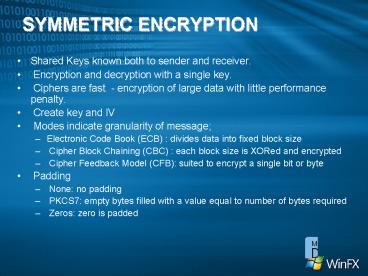SYMMETRIC ENCRYPTION - PowerPoint PPT Presentation
1 / 13
Title:
SYMMETRIC ENCRYPTION
Description:
Encryption and decryption with a ... Padding. None: no padding ... Zeros: zero is padded .net SYMMETRIC ENCRYPTION. SymmetricAlgorithm. TripleDES. 3 X 356 keys ... – PowerPoint PPT presentation
Number of Views:413
Avg rating:3.0/5.0
Title: SYMMETRIC ENCRYPTION
1
SYMMETRIC ENCRYPTION
- Shared Keys known both to sender and receiver.
- Encryption and decryption with a single key.
- Ciphers are fast - encryption of large data
with little performance penalty. - Create key and IV
- Modes indicate granularity of message
- Electronic Code Book (ECB) divides data into
fixed block size - Cipher Block Chaining (CBC) each block size is
XORed and encrypted - Cipher Feedback Model (CFB) suited to encrypt a
single bit or byte - Padding
- None no padding
- PKCS7 empty bytes filled with a value equal to
number of bytes required - Zeros zero is padded
2
.net SYMMETRIC ENCRYPTION
DESCrpytoServiceProvider
DES 56 bit
TripleDES 3 X 356 keys
TripleDESCrpytoServiceProvider
SymmetricAlgorithm
Rijndael Variable(1-2,048)
RijndaelManaged
RC2 128-, 192-, 256-
RC2CryptoServiceProvider
3
ASYMMETRIC ENCRYPTION
- Public and Private key generation.
- 1000 X slower than symmetric encryption.
- Most popular asymmetric encryption algorithms
- RSA (Rivest, Shamir Adelman)
- DSA (Digital Signature Standard)
4
.net ASYMMETRIC ENCRYPTION
RSA 3 X 356 keys
RSACrpytoServiceProvider
AsymmetricAlgorithm
DSA Variable(1-2,048)
DSACryptoServiceProvider
5
HYBRID ENCRYPTION
- Use both symmetric and asymmetric encryption for
large data. - Generate a symmetric key i.e. session key.
- Symmetrically Encrypt the content with a session
key - Use an asymmetric public key to encrypt the
session key. - Send both the data and encrypted session key.
- Recipient decrypts the session key with the
asymmetric private key. - Recipient decrypts the message with decrypted
session key.
6
HASHING
- Deals with data consistency i.e. integrity.
- Calculates a one-way cryptographic hash of the
message i.e. message digest - Message digest is one-way, fixed length, unique
ands relatively small. - One way so it cant be re-engineered.
- Hashed content is sent with the hash
- Hash algorithms
- Message Digest (MD5) 128 bit
- Secure Hash Algorithm (SHA) 160, 384, 512
variants
7
.net HASHING
SHA256
SHA384
SHA1
HashAlgorithm
SHA512
HMACSHA1
KeyHashedAlgorithm
MACTripleDES
MD5
8
DIGITAL SIGNING
- Authentication, Integrity and Non-Repudiation
- Authentication and non-repudiation with
asymmetric algorithm. - Integrity with hashing algorithm.
- Only private key owner can sign the message.
- Signature can be verified by anyone with public
key. - Only the hash value is encrypted. The message is
in original format. Proper security entails
encrypted message as well. - Process
- Compute digest (hash value) of content
- Encrypt hash value with private key to create
digital signature - Send content and digital signature to recipient
- Recipient calculates hash value of the message
using same hash algorithm as sender. - Digital signature is decrypted using public
asymmetric key. If decryption is successful
message is from sender. - Decrypted hash is verified with newly computed
hash no tempering.
9
.net SECURITY FRAMEWORK
- Salient features
- Provides the ability to create a security profile
that captures cryptographic level details - Associates the data with the security profile
- Hides algorithm level details inside a security
profile so that change of implementation is
flexible. - Binding between security profiles and data with
daclarative programming - Provides a unified API
- Steps
- Agree on a profile
- Bind the profile to the business object
- Identify extent of security required
- Implement the security attributes with providers
i.e. code that performs the cryptography based on
profile and attributes - Output a sectioned secured envelope from the
provider which contained secured payload - Send the envelope with its payload to receiver
10
FRAMEWORK OVERVIEW
11
(No Transcript)
12
(No Transcript)
13
(No Transcript)































